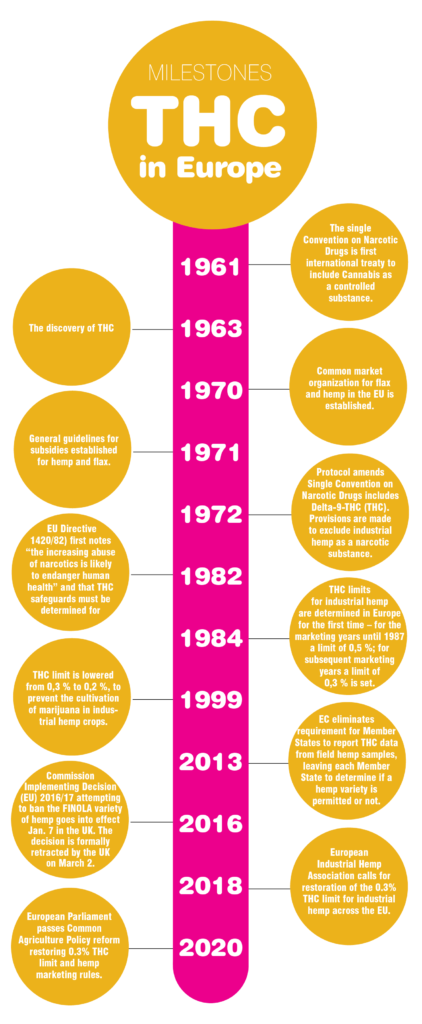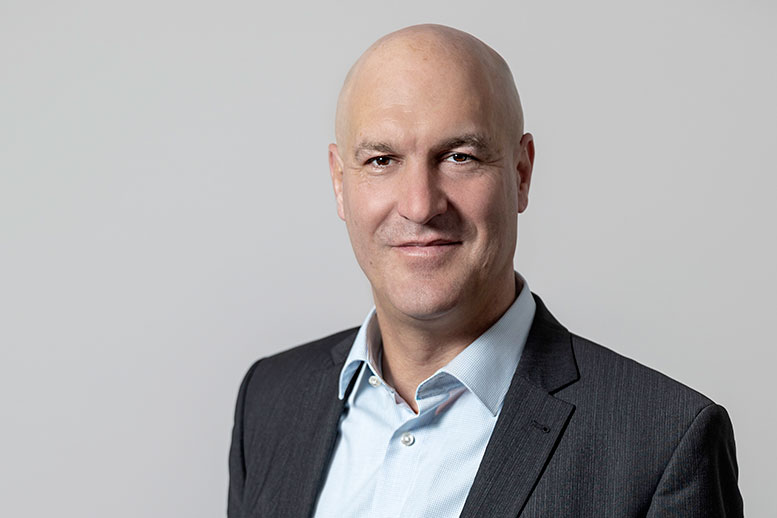Reverting to the 0.3% “on the field” THC limit for industrial hemp in Europe will lead to several opportunities for stakeholders on the continent, opening up possibilities for research and development of specialized cultivars for fiber, grain and flowers while also – finally – putting European hemp companies on a par with international markets.
“The reform lays out the basis for a growing, green, sustainable industrial hemp sector all over our union,” Daniel Kruse, President of the European Industrial Hemp Association (EIHA), said in the wake of the passage last week of Common Agriculture Policy (CAP) reforms that included the change.
“Finally, the EU has the chance for a level playing field with the global industrial hemp sector – again. And with upcoming marketing standards for hemp, the EU can gain momentum and catch up with the world,” Kruse said.
Marketing standards also critical
The standards, a second key component affecting hemp that was in the CAP reform bill, address a wide array of norms concerning such things as technical definitions, labeling, packaging, substances and methods used in production and farming, and other aspects involved in the hemp value chain.
Application of the marketing rules to hemp, which EIHA had also pushed for, will improve the economic conditions for production and marketing as well as the quality of agricultural products.
After passage by the Parliament, the CAP reform bill now goes to the European Commission for final approval, which is based on votes of individual member states. “The member states should follow the European Parliament and lay the basis for a growing, green, sustainable industrial hemp sector all over our union,” said Kruse, who expects no significant pushback from Commission members.
What THC change means
What does the increase of THC allowable in European hemp mean for the market?
First, it will expand the number of existing hemp strains available to European growers, who have been limited to roughly 60 varieties under the 0.2% THC constraint. Those varieties include a number of existing high-yield hemp cultivars from Northern and Eastern Europe that have been dormant in the European market because they exhibit THC levels beyond 0.2% but less than 0.3%.
Perhaps more importantly, it will rejuvenate seed science, leading to the development of more specialized varieties for fiber, grain and inflorescences (flower and leaves) that European researchers were not incentivized to develop under the 0.2% THC limit.
“European hemp breeding projects will finally have the chance to compete with the sector globally, and can play a major role in the upcoming years,” Kruse said. “
An expanded range of planting seeds will give farmers a wider selection of hemp varieties that can adapt to different soil and climactic conditions, resulting in plants that have higher resistance to diseases.
While those developments are welcomed, Kruse said it is far too late for Europe to catch up in the global CBD market. “The isolate market is already gone for European producers,” he said. “The latest development regarding the THC increase to 0.3% came far too late. There is no chance for Europe to catch up with isolate production in the short-term.”
Modern history: THC levels in Europe
Europe’s THC limit for hemp was originally established in the modern era at 0.5% in 1984, then trimmed to 0.3% in 1987 based on a highly recognized study by American plant scientists Ernest Small and Arthur Cronquist carried out in the 1970s on behalf of the International Association for Plant Taxonomy (IAPT). That study, based on the dry weight of hemp flower material, established 0.3% THC as the barrier differentiating Cannabis sativa (non-drug cannabis – industrial hemp) from Cannabis indica (drug cannabis – marijuana). Generally looking to Europe as the pacesetter, the 0.3% standard was soon taken up by Canada and other countries, and eventually by the United States when the U.S. Farm Bill of 2014 allowed American growers to re-start the industry there.
As hemp re-emerged in Europe near the end of the last century, a new generation of stakeholders put the primary emphasis on growing for fiber applications. Meanwhile, Europe took a step backward in 1999 – somewhat inexplicably – by further reducing the allowable THC level for hemp to 0.2%. Why?
The role of France
France, at that moment, was well-positioned to reap the benefits from hemp, having developed low-THC hemp strains throughout the 1980s and 1990s that were feeding into the country’s paper making and construction sectors. There is ample reason to think that lowering the THC limit for industrial hemp from 0.5% to 0.3% and then to 0.2% was perhaps not initiated, but surely not opposed, by French breeders of cultivation seed.
Anxious to stay in line with EU guidance, and still under the shadow of the global war on drugs, other European growers were forced to comply with the 0.2% THC benchmark if they wanted to grow hemp. It was the only ticket to EU subsidy programs designed to support the crop; the subsidies were particularly popular in France, the European hemp fiber production leader, and where the government from time to time sweetened the pot by tacking on additional national subsidies.
Setting things in motion
As the 21st Century dawned, more and more companies began to realize hemp’s potential for food, as well as the health benefits inherent in hemp-derived CBD, which rises in proportion to THC levels in industrial hemp.
It was Kruse’s firm, Dusseldorf-based HempConsult GmbH, that first began to explore the rationale and impetus for Europe’s outlier 0.2% THC limits – in a paper issued nearly a decade ago. That initial study eventually set in motion the changes now underway in Brussels after EIHA later took up the THC agenda, eventually issuing its own analysis in 2017.
As supplements and hemp foods started to hit the mainstream all over the world, CBD quickly grew to account for well over half of global hemp industry revenues. In that fast-growing environment, the EU’s 0.2% THC limit put Europe’s market participants at a severe disadvantage.
Upon final approval of the changes carried by the CAP reforms, the handicap on EU hemp will be overcome. Said Kruse in the wake of the European Parliament’s vote last week: “When we first raised this topic 10 years ago, almost no one understood the background and importance of this issue. Because of the ten years waiting for this moment, I am today, for sure, the happiest person in the European Union.”
The long road back to 0.3%


